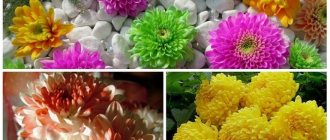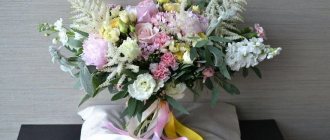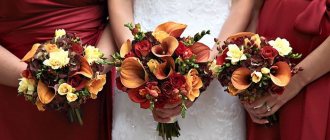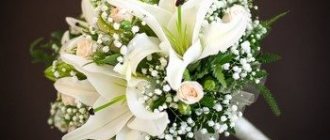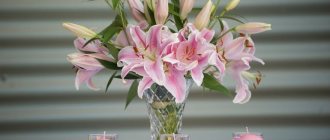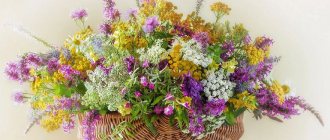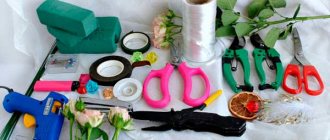The chrysanthemum is given many names: “sunny flower”, “imperial flower”, “golden flower” - and all this because Japan is considered the birthplace of this beautiful plant. This country even celebrates Chrysanthemum Day. The symbolic number 9 opens the date of the festival, and to be precise, the Japanese celebrate the flower festival of the 9th month on the 9th day. On this day, the streets are decorated with various figures and bouquets of this delightful flower. Sometimes bouquet compositions resemble animals, monuments, statues of people, symbols of countries and cities. Every craftsman can create a floral masterpiece. You just need to show imagination and patience. In our article we will clearly look at how to make a bouquet of chrysanthemums with your own hands in various variations.
Chrysanthemums in floristry
Chrysanthemums belong to the Astrov family. They take second place in the world after roses in the number of cut flowers grown. Its popularity is also explained by the fact that during the year you can harvest 3-4 crops in a greenhouse. The inflorescences consist of tubular and reed flowers, which are colloquially called petals. Due to the abundance of sizes, shapes, types of inflorescences and constant selection, the plant is difficult to classify. The most famous is the division into 13 groups according to the type of flowers:
- randomly bent;
- wrapped;
- symmetrically bent;
- intermediately bent;
- decorative;
- pompons;
- anemoid;
- arachnids;
- spoon-shaped;
- feather-like;
- racemose;
- single semi-double;
- unclassified when several varietal characteristics are present at once.
All these varieties are used in bouquets and compositions. Small-flowered button-shaped chrysanthemums are often used to create designs in the form of soft toys or other stylized figures.
The following shades have been developed by hybridizers:
- pink;
- purple;
- lilac;
- red;
- yellow;
- orange;
- bronze;
- white;
- green;
- brown.
Some varieties are distinguished by their bicolor, different shades on the outside and inside. These features are used by breeders to develop new tones by clipping flowers of one shade, then cross-pollinating and cultivating another.
A cut chrysanthemum will last in a vase for 2-3 weeks without special care, and if a number of rules are followed, it will delight the eye for a month and a half:
- after cutting, they are brought into a cool, damp room: basement, cellar, refrigerator with a temperature of +4 degrees;
- The lower leaves and branch shoots are removed from the stems;
- the edge of the cut is broken with hammer blows or 8-10 cuts are made with a knife to a depth of 10-12 cm;
- before transportation, plants are watered for 2 hours at a temperature of +5 with ice added to the water;
- transport chrysanthemums without water, standing in dry boxes or lying down;
- large-flowered plants wither faster;
- small-flowered ones are cut off when the bud is fully colored when the size reaches 1-2 cm, large-flowered ones - 4-6 cm;
- unopened buds in a warm room +22 and a nutrient solution will bloom in a week.
Rules for cutting flowers
When cutting, it is important to follow simple requirements that ensure a presentable appearance for the bouquet for a long time:
- Cutting is carried out using a high-quality sharp tool - pruners, scissors or a knife. Sharpness will ensure an even and quick cut without damaging the plant stem.
- The cutting surface of the tool should be periodically washed or wiped with a cloth moistened with a disinfectant liquid to prevent the transfer of possible bacteria to a healthy bush.
- If possible, place the ends of the stems in water immediately so that air does not enter the cavity and the drying process does not begin.
- Store cut flowers in a cool room so as not to prematurely start the process of wilting.
- It must be transported horizontally, wrapped in a damp cloth.
- Before placing flowers in a vase with water, you need to refresh the cut along the bias and make cuts along the circle so that you get a “tassel” at the ends - the fibers will increase the area for water absorption, and the plant will be better hydrated.
Florists use all these secrets to extend the life of flowers.
It will also be interesting: Lilies in landscape design - in the garden and in the flowerbed, how and with what to plant ⚜
Making a bouquet of chrysanthemums with your own hands
Chrysanthemums are delicate flowers. But they only look tender; in fact, the chrysanthemum is not picky. Such a bouquet will last a long time in a vase, pleasing the recipient's eye. To arrange a bouquet of chrysanthemums, you can use the following materials:
1. Transparent film.
This composition can be given as a gift for Knowledge Day and birthday. A person who loves chrysanthemums will definitely appreciate the simple but neat design. This option allows you to focus on the beauty of the flowers without being distracted by extraneous objects in the bouquet. To decorate the flowers a little, you can use glitter mixed with water. Florists apply them using a sprayer.
2. Felt + mesh.
This unusual combination of materials will delight even the most fastidious recipient with its originality. Felt is a material that is rarely used by florists. Now felt has become very fashionable. The mesh is an indispensable “ingredient” of a modern flower arrangement. You should choose a mesh for chrysanthemums in a contrasting color. For example, for white chrysanthemums you can choose a purple or yellow mesh.
Arranging bouquets is a fun and interesting thing. If you approach it with your soul, you can become a real professional for a few minutes and decorate the composition no worse than a florist with extensive experience. You can find many master classes on the Internet that will help you combine materials and flowers. The main thing in this matter is to put your soul and feelings into it: then the recipient will definitely be happy when he receives your bouquet.
Bouquet decoration
Design options for the “royal duet”
One of the most popular flower combinations, it suits almost all arrangements that are fashionable today. For example, a bouquet of small spray roses and chrysanthemums is ideal for decorating hat boxes or other similar compositions. And varieties with large buds will effectively decorate a wedding accessory or interior.
A bit of southern exotica
When choosing a bouquet, brides place many conflicting demands on it. They want the floral accessory, on the one hand, to impress others with its originality and splendor, and on the other hand, not to be ruinous for the budget. Both wishes are quite feasible if the bouquet arrangement consists of roses, chrysanthemums and alstroemerias. And besides, it is assembled with your own hands.
Lush chrysanthemum buds will add volume to the arrangement, allowing you to save on more expensive plants, and exotic alstroemeria, with its unusual shape and tropical butterfly coloring, will add the missing shine.
You will need:
- fresh flowers, as well as sprigs of pitosporum and gypsophila for decoration;
- porta bouquet holder;
- satin ribbons and openwork braid;
- Double-sided tape;
- twine or tape;
- pruner
- We remove the “Oasis” from the portbouquet and immerse it in a container with water at room temperature. While it collects moisture, fill the handle of the floral device with scraps of paper towel to avoid possible leakage.
- We trim the pink stems and adjust the remaining fragments to the length of the handle of the purse with some margin. We “hide” the holder behind the floral material. We glue the stems with double-sided tape and secure them with twine or tape to be sure.
- We cover the lower part of the porta bouquet mesh, where the “oasis” is inserted, with large leaves: pink, hosta or aspidistra, to choose from. Return the water-soaked floral sponge to its place and secure it.
- Next, we decorate the holder with a satin ribbon, covering the tape, twine and other “subtleties” that are not intended for public viewing. We make an elegant “cuff” from openwork braid.
- We start assembling with pink buds of two shades - pink and ivory.
- We place chrysanthemums between them, and complete the composition with exquisite alstroemeria, pitosporum and gypsophila.
Holiday mix
A charming bouquet of spray roses and chrysanthemums, as well as eustoma, statice and carnations, is simply created to be given for a birthday or other important date. An elegant combination of rich and pastel shades, a variety of textures, dynamics added by greenery - all these details create a bright, festive mood. The process of creating such beauty is recorded in the photo, so it will not be difficult to repeat the actions of a professional florist.
The arrangement is made up of flowers of a nuanced range, but differing in tone. There are very delicate, light buds and specimens of a dark shade. Thanks to skillful selection, it is possible to avoid both sharp contrasts and boring monotony.
Several types of plants and a sprig of ruscus are used as a base.
Next, we alternate flowers and greens, trying to have buds of different varieties and colors nearby.
We tie the finished composition with floral tape. If there are a lot of colors and the accessory from them turns out to be heavy, you must first use anchor tape.
We straighten the stems so that they are the same length.
An arrangement correctly assembled using the spiral technique can stand without any support.
The floral accessory itself has a complex structure, so its packaging should be as simple as possible. A sheet of non-woven fabric of a suitable shade is enough. Instead of ribbon, use colored raffia.
The bouquet mix turned out to be light and fresh in spring:
Back to school
Traditional gift arrangements for September 1st are rarely complete without the “Queen of Autumn”. In tandem with small spray roses it looks very elegant. The teacher will definitely give you the highest score!
An unusual decorative element will be a bunch of bergrass, rolled into a ring and attached to a wooden skewer.
When composing the arrangement, we adhere to the same spiral principle.
In addition to bergrass, an interesting addition to the gift will be spikelets of bread.
Non-woven fabric will help out this time too, wrapping the flowers in a delicate white “cloud”. Sheets of material must be folded diagonally with an offset to form not one, but two corners. And then wrap the plants, laying them overlapping.
Bears rode a bicycle
And here is a wonderful gift for your beloved, assembled independently by men’s hands. The “highlight” of a miniature bouquet of 3 roses and several chrysanthemums is, of course, a decorative flowerpot-bicycle.
A floral base soaked in water and wrapped in polyethylene is inserted into it so that moisture does not seep out.
A linear technique of assembling the arrangement is used, and picturesqueness is achieved by varying the height of the flowers. Let's start with the main accent - pink buds.
We place the “Queen of Autumn” in two rows, alternating with graceful branches of solidago. Let's put a funny tilde bear behind the wheel. Let the “flower joy” take you to its intended destination.
Bouquet packaging
This is not given the due amount of attention, but balance is important. Some people are sure that the filling plays the most important role in a bouquet, while others believe that the packaging should be as beautiful as possible, because it is the first thing people see.
What people forget about is that the bouquet should look harmonious and balanced.
There are many options for packaging film for bouquets. Instead, craft paper is now often used. Partly because minimalism and practicality are becoming more and more popular in all areas of life.
There is also mesh waterproof paper, and simple tape in the right hands can become wonderful packaging.
The best combinations in a bouquet
Gerbera is a catchy flower and is almost always the dominant chord in a bouquet, and therefore a mono-bouquet will look very advantageous in the hands of the bride. The best combination in this case is floral greenery. Here you can experiment endlessly, choosing the most harmonious options.
Mono bouquet orange
However, if the bride wants to diversify her image, then you can pay attention to combinations with alstroemerias, irises, chrysanthemums, and large daisies. For lovers of the extravagant, a combination of large-headed burgundy roses and white gerberas is suitable
Combination of hydrangea, freesia and gerbera
How to make a fruit bouquet with your own hands in 15 minutes
A fruit bouquet is a great opportunity to please your mother on March 8th. Handmade gifts are always dearer to the heart. Fortunately, florists and folk craftsmen have come up with a lot of possibilities for new surprises. Here are instructions on how to make a delicious bouquet in 15 minutes. Time has passed.
- Wipe the lemon, kiwi, grapefruit and 3 apples with a damp paper towel. Dry with a kitchen towel.
- Cut the top off the grapefruit. Cut the lemon and kiwi in half. Pack each cut in cling film. So, 7 minutes have passed.
- Place the fruit on long skewers. It is better for the fruit to be on the table. Apples and grapefruit will contain 3 sticks each, lemons and kiwis will contain 2 sticks.
- Gather the sticks in your hand. Secure with tape. Basically, you've almost done it.
- Pack in gift paper. Stick flowers and green twigs into the empty spaces. Phew, we made it.
Alstroemeria propagation by seeds and division
Alstroemeria propagates by sowing seeds or dividing the rhizome. We sow seed directly into open ground in early spring, since all types of parrot lily tolerate low temperatures well. The most valuable varieties and hybrids of this flower can be grown in seedlings. We sow the seeds (beginning of March) in containers or peat pots filled with nutritious soil mixture. Then lightly press them in and sprinkle them with substrate. A mixture of turf and leaf substrate is excellent for sowing.
We moisten the crops from a spray bottle with water at room temperature, cover them with glass or polyethylene and place them on a well-lit windowsill. We water as the soil dries, and periodically remove the glass for several hours to ventilate the crops. The first shoots of parrot lily appear after 18-22 days. We harden the grown plants for a month at a temperature of +5 degrees.
Landing at a permanent place
We plant young seedlings in open ground when the threat of frost on the soil disappears. The most suitable time for this is the end of May. We plant alstroemeria seedlings (and petunias along with it) on a warm day. It is best to plant young plants on a cloudy day so that they do not suffer from the scorching spring sun.
The depth of the hole directly depends on the size of the seedling. The interval between seedlings should be about 30-35 cm. If planted more densely, overgrown bushes will be difficult to care for. When planting seedlings, add a small amount of organic matter (rotted manure or compost) to each hole. After planting the plants, mulch the soil around the stem with compost.
Peruvian lilies grown from seeds bloom only in the second or third year after planting, so gardeners prefer to propagate them by dividing the rhizomes. We carry out this procedure in the spring (at the beginning of the growing season) or in the fall (after the buds have faded). In the spring, we divide the rhizomes when the ground has warmed up well. Specialized stores are increasingly selling cuttings of this flower, which are characterized by excellent survival rate. Adult plant specimens grown in a summer cottage are also suitable for propagation.
To obtain high-quality cuttings, we dig up alstroemeria bushes using garden forks. We divide the rhizome into 2-3 parts. When cutting it into more parts, new plants take root and develop worse. Each division should be healthy, well developed and strong. It should have at least 8-10 eyes. To prevent the penetration of pathogenic microorganisms, we treat the cut parts of the rhizome with a pink solution of potassium permanganate.
We plant 3-4 cuttings per square. The depth of the hole is determined by the size of the rhizome part. Most often it is 20-25 cm. We mulch the soil around the stems with compost. Usually the plants take root well, but do not produce flowering shoots in the year they are planted. Bushes grown from small and weak cuttings bloom only after 1-2 years. To obtain abundantly flowering plants within a year, parts of the alstroemeria rhizome are planted in a permanent place in the fall, namely in September-October.
DIY bouquet for September 1st
DIY bouquet for September 1st
By September 1, flowers are always very expensive, because on the eve of this holiday, the rush for gift arrangements begins.
But every parent will be able to make a bouquet for September 1st with their own hands. Prepare flowers and tools:
- Yellow roses
- Green chrysanthemums
- Sedum
- Small blue asters
- Secateurs and scissors
- Wrapping paper
- Decorative elements
Compose the bouquet as follows:
- Start assembling the composition using the spiral technique, placing all the flowers scattered, but in tiers. This is necessary so that you want to look into different parts of the bouquet and consider its beauty. Carefully trim the lower leaves with scissors
- Once all the flowers are in place, secure the stems with tape and trim them with pruning shears
- Pack the composition in decorative paper and decorate with themed elements
Detailed stages of making such a bouquet can be seen in the video below.
Preparatory stage
Assembling bouquets begins with preparing raw materials and tools. Raw materials are primarily the flowers themselves, as well as auxiliary elements:
- small buds and flowers;
- green twigs, grass, ferns;
- decorative accessories - butterflies, bears, hearts, etc.
The tools you need are scissors or pruning shears, a knife; a stapler and office adhesive tape will speed up and make the work easier (florists use special professional tape). You will need decorative mesh, film or paper to wrap the finished bouquet, perhaps some additional tools or decorative details.
Next you should prepare the flowers and greens. Preparation consists of stripping the lower part of the stems from leaves and thorns. In addition, flowers need to be sorted by length and size.
Important: in order for the bouquet to look harmonious, you should remember one simple rule: the part of it that will be in a bunch or in a vase is equal to approximately one third of the total height of the composition. There are other proportions - five parts of the height of the flowers remain outside, three parts are immersed in the vase. This rule works for classic vertical bouquets.
Chrysanthemums and wedding
Fresh flowers can transform any holiday into a fairy tale. No wedding is complete without flowers. In combination with tenderness, romance, purity, florists pursue the idea of creating luxury and celebration.
Against the general background of the availability of any flower arrangement, a bouquet of chrysanthemums does not lose its relevance. They are harmoniously placed around the perimeter of the room, as well as on guest tables.
Chrysanthemum rightfully takes its place of honor - the attractiveness and freshness of the flower are preserved for a very long time. The lightness and airiness of the flower are reminiscent of the legend that it symbolizes eternal youth and beauty.
Be that as it may, we are dealing with a cut plant. To make a bouquet of chrysanthemums last longer, you need to follow the rules:
- flowers should be broken rather than cut;
- if a cut is unavoidable, it should be at an oblique angle. This can be easily done with pointed pruning shears.
From a flower that has bloomed three-quarters, shoots are removed, leaving up to three to four leaves below. The procedure is performed in the morning or evening. When immersing a bouquet of chrysanthemums in water (photos of which you see in our article), throw an aspirin tablet or a pinch of salt into the container.
Water should not exceed half the length of the stems. Where the water is chlorinated, it is advisable to take the settled liquid. Some people resort to this trick: they add a little solution of potassium permanganate or lapis to the water.
How to choose fresh chrysanthemums when purchasing
If you decide to buy a chrysanthemum for the composition, due to the lack of your own material, then it is advisable to understand how to determine the freshness of the flower:
- The petals should be evenly colored. Without red and yellow spots, both in the middle and along the edge of the flower.
- It’s good when there is at least a small amount of foliage on the stem above the middle. The absence of leaves, dark spots, dents is a reason to refuse the flower, it is stale and will not last long.
- When you try to break off the lower edge of the stem, you hear a characteristic biting click. A flaccid stem does not make a similar sound; it gently crushes and does not break off at all.
- If you turn the chrysanthemum upside down and shake it slightly, all the petals remain in place. If the product is stale, they will fall off.
- Gentle pressure with a finger on the core does not deform the flower; crushed petals quickly restore their original shape.
- The plant exudes a specific, recognizable chrysanthemum scent. In withered flowers it is more intense and rancid.
- Natural shade and natural shade are an indicator of the freshness of the flower. An abundance of sparkles, a sticky varnished structure and flashy ultra-bright shades can mask the final fading. If you want to add sparkle to the chrysanthemums, you can ask the seller about it, and do it immediately before purchasing.
The appearance of chrysanthemums
Japan is considered to be the birthplace of the chrysanthemum. In this country, this flower is called “kiku”, which can be translated as “sun”. Even in the last century, the image of a chrysanthemum was sacred, and only members of the imperial house had the right to wear robes decorated with images of these delightful buds. Ordinary people who dared to decorate their clothes with chrysanthemums were punished by death. Today in Japan the highest state order is called the Order of the Chrysanthemum, which adorns state flags, postage stamps and coins. Chrysanthemums arrived in Europe only in the 17th century. The Dutchman Reede brought them from Japan to England. However, the French have a different opinion on this matter: they are convinced that chrysanthemums first appeared not in England, but in Marseille, this happened in 1789. The flowers were delivered by the famous French traveler Pierre Blankshire. However, these plants looked more like daisies, and therefore did not make the desired impression. Only in the 19th century, the experiments of a French gardener made it possible to obtain unusual varieties in which the public became interested. The developed varieties began to be grown in gardens throughout almost all of Europe. They tolerated drought, heat and even English fogs perfectly, decorating gardens until frost.
Beauty from time immemorial
The desired composition will convey the underlying deeper meaning. Chrysanthemums will help you avoid unnecessary words, communicating in the language of flowers.
By looking into history, you can find out what these mysterious plants can tell about. From the word forms “flower” and “golden”, translated from Greek at one time, the name “Golden Flower” was obtained. The ancient chrysanthemum had a definition that suited the yellow-gold flower very well.
The popularity of chrysanthemums in Ancient China is proven by images on ceramic dishes and vases. The flower that has come down to us has a rich color palette.
Several varieties of flowers have evolved from two subspecies of chrysanthemums. They are so different from each other that it is not immediately possible to determine their relationship.
Chrysanthemum acquired resistance to temperature changes due to its origin in harsh climatic conditions.
Suitable varieties of chrysanthemums for making beautiful bouquets
Chrysánthemum is a perennial with a top part that dies in winter and is renewed in spring. There are varieties that cannot withstand extreme cold. Yes - frost-resistant. But regardless of belonging to a specific variety, any variety is suitable for creating a bouquet. Many species and varieties are classified according to different criteria. They can, for example, be divided into two groups:
- small-flowered, also called “oak” because of the shape of the leaves;
- large-flowered - owners of not only large flowers, but also leaves - they are wider and longer.
It is interesting to combine them in bouquets, placing them in a certain pattern or combining each with other types of flowers of similar size.
The second option for dividing chrysanthemums is by flowering time:
- early - bloom from July to October;
- medium - for the autumn months;
- late ones are frost-resistant, bloom in November-December.
Such information must be taken carefully, since having planned a composition of specific varieties, one of them may simply not be found due to a mismatch in the flowering period.
According to the flower shape, chrysanthemums are terry, pompom, anemone-shaped and single-row. This makes them so different that the field for imagination here is simply gigantic.
It will also be interesting: Lily Friso - description and care, planting and growing?
Decor
Gerberas look great on their own, but if desired, they can be supplemented not only with fresh herbs, but also with a wide variety of elements:
- rhinestones or beads can decorate the leg or be glued directly to the petals to imitate dew drops;
- berries or fruits are good in a composition for an autumn celebration - this will instantly add warm comfort to the composition and organically fit into the surrounding nature;
- In winter it is not forbidden to use spruce branches, and in spring - willow.
A universal solution would be artificial elements in the form of butterflies, hearts, and doves. The leg can also be decorated in a variety of ways - with a string of beads, lace, an interesting texture of fabric, sparkles.
A few recommendations for floristry
Below we present three different types of compositions that are made at home.
How to make and arrange bouquets of fresh flowers step by step
Let's define the term simplicity. In floristry, this word means mono-bouquets, combinations of two, less often three varieties or flowers. No need to play with position and placement, with sizes. Example: three-color ikebana made from home-grown lilies.
- We cut 9 stems - 3 of each shade. We make the leg longer and straighter; this variety assumes large, spreading branches. Colors are white, yellow and orange.
- We remove excess branches that interfere with connecting and placing the stems next to each other. Cut them carefully so that the skin does not begin to stretch over the entire base.
- As stated above, we apply the flowers, forming a single cap - from the center along the circumference downwards.
- The color should be spread asymmetrically so that three tones do not touch next to each other.
- Now we bandage the point of contact.
- We trim the lower part, leaving 7 - 10 centimeters from the tape.
Lilies don't need packaging because they have beautiful lush foliage, which is why this option is called easy.
What does a specialist think about this:
How to make a mini-bouquet of fresh flowers yourself
Miniature compositions hold well in the hand, can be easily transported, do not get in the way when worn, and can easily fit into almost any vase. Their peculiarity is that, having a small height, they are quite padded. In some ways they resemble classic wedding ones, but are not as heavy and take up much less space in diameter. How to cook them:
- Since there will be only a few components, you should not take many varieties. The best option is 2 different varieties and some greens.
- Suitable combinations: eustoma + chamomile; gerbera + chrysanthemums; hydrangea + cloves.
- >Twigs can be: gypsophila, fern, ruscus, salal.
Now we adhere to the recommendations for drawing up:
- One (or three) large bud, the rest are small.
- The shape is an envelope, that is, on a plane, there are flowers placed higher up and those that are lower.
- You need to use packaging; craft paper usually works very well.
- The height of the entire bouquet is up to 50 cm.
This shows how easily and quickly you can pack this option, let’s look at the master class:
DIY rose bouquet step by step with photo examples
What housewife would not have a rose garden in her own front garden? Usually rose bushes are the pride of the gardener, so they are often made up of them. Let's give step-by-step instructions:
- cut the stems so that they are all the same size and even
- domestic roses have very sharp thorns - remove all thorns from the lower half, which you will hold on to;
- choose the form of the further composition, it depends on how many and what colors and sizes of buds, as well as on the subsequent desire to pack it;
- assemble all the legs using tape in the manner described above, tie the tape;
- move on to decoration;
- cut off any excess ends.
We recommend diluting mono bouquets if they are entirely made of flowers of the same color and variety. This can be done with small bush flowers and herbs.
Now let's look at photo examples. You can get inspiration from here:
Let's see how a florist puts together a composition step by step:
Tips for assembling a flower arrangement
We offer recommendations given by florist experts. Things to consider:
- Check the style carefully. Already at the idea stage, you should clearly understand who the surprise is being prepared for. Important: gender (calla lilies, chrysanthemums and other masculine options are suitable for men), age, situation and reason for presentation.
- The best image is natural; it is better to allow asymmetry and unsystematicity.
- Each element of the composition must be self-sufficient and visible at first glance; for this, the buds cannot be “hidden” under the foliage.
- You need to decide where is the front and where is the back. If you are making a ball shape, as with wedding designs, there should be the most successful angle - the main one.
- The color can be different (it’s good to play with contrast, for example, beige and burgundy) or the same, but in the latter case, with different varieties of flowers, it is worth choosing different shades so that all the plants do not mix into one color spot.
- White looks great. It visually enlarges the bouquet and also combines with other flowers.
- You can use a photo and make bouquets of fresh flowers step by step, then you will definitely not forget the sequence and do everything well the first time.
How to collect songs
Auxiliary tools and plants should be used. In the process of tying the stems, they need to be applied one to the other so that they are laid between different fingers. This will allow you to check the specific distance that needs to be created. When you have determined from the head (top part) how close and in what place the buds should be, you can insert a wad of tape between the stems. If you don’t need to move them apart, you can simply rewind the legs at the required angle.
The tool immediately used is a pruning shear. Sharp scissors that are powerful enough to cut through the strong base of a flower. If you collect plants from the front garden, then you probably have one. Do not immediately adjust the length. You may have to rearrange the composition. You just need to remove the strongly interfering, protruding parts.
Now you need to do this sequence several times in a row, and at the very end, wrap the entire junction of the elements with tape. Move on to decoration.
Let's see how the wizard does it:
How to make a beautiful bouquet of fresh flowers with your own hands
Now let's move on to beauty. Home-grown flowers often differ from store-grown ones. They are less smooth and have errors. These are small flaws if you make them up correctly. The first problem is that they do not have perfectly straight stems, and the length is often different. For this reason, it is almost impossible to do without packaging. You can use craft or corrugated paper, patterned cellophane, or special packaging materials that are commercially available.
You need to fill the space between the buds with something. We recommend adding sprigs of greenery - they look advantageous and refresh the composition.
For registration you should:
- decide on the size of the flowers, trim the lower part according to this imaginary line;
- cut the packaging into equal pieces;
- apply it in layers so that the sheets overlap each other;
- fasten them with a stapler from the inside so that no folds are visible from the outside;
- use tape for tying.
In this section, we will give recommendations on which shades of wrapping paper go well with the color of the composition:
- red and burgundy roses - beige, black, white, with newspaper-shaped ornaments;
- >pink buds – lilac, blue, brown, mint;
- white, beige, other light shades - any nude tones of paper.
You can almost always use a game of contrast. If you don’t know what palette to use for the design, use transparent cellophane or discard it altogether.
Here's how a florist does it:
"Misha for Masha"
Toys made from fresh flowers are a very cute gift for little birthday girls or young girls. Small-flowered chrysanthemums are used for such compositions. Thanks to the durability of this flower when cut. Moreover, the basis will be piaflor, watered with a nutrient solution. To create the Bear we will prepare:
- piaflora bars 2-3 pcs.;
- green small chrysanthemums 4-5 branches;
- yellow small-flowered chrysanthemums 2-3 branches;
- a piece of textile for a scarf;
- toy eyes and nose from a craft store;
- stationery knife;
- wooden skewers and toothpicks;
- nutritious powder for cut flowers;
- a bowl of cold water;
- stand and other decor: a ball, a basket, a mushroom or other elements.
Making a Bear:
Floral sponge piaflor is easily cut using a florist or stationery knife. We give the elements the shape of a fairy-tale hero.
We assemble the parts using wooden skewers.
We place the bear collected from piaflora in a bowl with a dissolved nutrient solution.
We cut chrysanthemum inflorescences from the branches and use toothpicks to attach them to the nourished PR flora. Let's start with the muzzle.
Attach the eyes and nose.
We tie a bow around the neck of the toy and decorate it with additional elements.
Our store offers a wide range of bouquets and fresh cut flowers. Low prices in our store are due to the fact that we purchase flowers directly (bypassing market intermediaries) from our partners in Russia, the Netherlands, Colombia and Ecuador. When choosing our product, you can be sure of the quality and freshness of the flowers, since less than 24 hours pass from the moment of cutting to the receipt of the goods at our warehouse. All flowers are stored in a specially equipped refrigerated room, where they undergo careful selection before they fall into your hands. LasFlore provides prompt delivery of bouquets throughout Moscow and the Moscow region by qualified couriers. Our operators and florists will help you order a bouquet and related gifts for any occasion. Order execution time is from 2 hours. Our online flower shop is able to surprise and amaze even the most demanding client.
Please your loved ones with magnificent and fresh bouquets, roses, gerberas, irises, lilies, alstroemerias, tulips and many other flowers at any time of the year, and we will help you with this. LasFlore – give flowers more often!
Interesting facts about this plant:
- chrysanthemums retain external freshness for a long time. Therefore, they are often used for various bouquets. The flower is suitable for interior decoration;
- There are hundreds of varieties that differ in the number of inflorescences on the stems, the size of the inflorescences, and color. This gives a lot of ideas and opportunities for florists;
- these flowers are good even on their own. They look great without other plants. The composition may also have additional accents;
- The plant looks harmonious in the company of roses, gerberas, and daisies;
- It is appropriate to give at any time of the year. But buying chrysanthemums in the fall is especially important.
This flower is unobtrusive and does not have a strong smell that could cause a headache. It is suitable for any gift. It is customary to give it as a token of gratitude to loved ones, friends, and teachers. And you don’t necessarily need to look for a reason for such a present. The affordable price of chrysanthemum is another advantage of this flower.
Practical advice
The two “royals” look most harmonious in round bouquet arrangements arranged in a spiral. This type of arrangement emphasizes the beauty and advantages of each of the flowers. The mix is also good in creative “umbrellas”, “fans”, “handbags” or “muffs”, creating a dense, uniform coating of the base.
However, if creative compositions require professional knowledge and experience, then everyone can put together a simple spiral bouquet. Its advantages are symmetry, neat shape, ample opportunities for decoration, and splendor. Depending on the number of flowers, it can be a modest “compliment” bouquet or an impressively huge one, appropriate for a significant event.
The algorithm of actions is as follows:
- Flower stems are cleared of lower leaves, which will rot in the vase. The thorns of roses are additionally cut off. It is best to carry out manipulations under running water to avoid the oxidation process.
- Next, they begin assembling around one central flower. How to choose the main accent? It can be a large single-headed chrysanthemum of an unusual shape - spherical, ray-shaped, needle-shaped or pompom-shaped. Or a pink bud with a cupped silhouette. It is important that the second “participant of the duet” be much smaller.
- Accent buds are grouped in the central part, and plants playing a “secondary role” are grouped in the periphery. The color should also be active in the “core” of the bouquet, and then gradually soften. Thanks to this technique, the composition looks more airy and voluminous.
- Secondary flowers are applied to the central one at an angle to form a lush cap. At the same time, they move in a circle, adding more and more new plants.
The finished composition is fixed with tape, and the stems are cut to the same length.
If you tie a spiral bouquet higher, closer to the flower buds, it will be denser and more compact. If lower - loose and fluffy.
Tight assembly is recommended for arrangements that will remain without water for a long time, primarily wedding ones. If a flower withers, this often happens with bush varieties of roses - they are not very durable, and the buds located nearby will not allow it to bend. Thus, the bride's accessory will seem fresh for many hours.
How to extend the life of an arrangement
“Queen of Autumn” is distinguished by its great resistance when cut, sometimes it even takes root in a vase, which makes it possible for further cultivation in the ground. Pink buds are much more capricious and vulnerable. It is best to disband the arrangement with them at the first opportunity and arrange all the components separately.
If you want to preserve the floral “duet” longer, you should trim the stems of both plants, using only a knife and moving obliquely to obtain a sharp angle. Next, the hard “legs” are slightly cut or crushed with a hammer so that they better absorb moisture. The advice applies to both roses and chrysanthemums, especially bush varieties, if they are not separated into individual branches.
The water in the vase must be changed every day, while trimming the flower stems. For feeding, it is recommended to use sugar in a 10% solution, both ornamental plants love it, and for disinfection - aspirin. Fading buds are immediately removed.
Symbolic meaning
It is nice to receive even a simple bouquet of chrysanthemum roses as a gift, as it symbolizes joy, prosperity and longevity. If you want to give a flower tandem a special meaning, you need to carefully select the shades of the buds. Often, royal beauties themselves have one meaning, but together they speak of something else.
The following table will reveal the nuances of the subtle language of floral symbolism.
| Roses | Chrysanthemums | In composition |
| Red - passion, strong love, admiration for the object of feelings. | Yellow - in the east means success, wisdom, wealth, health. | An offer of marriage. |
| White – innocence, purity of feelings, fidelity. | Devotion, sincerity of intentions, impeccability. | They symbolize the best feminine qualities of the bride. |
| Pink – tenderness, coquetry, easy falling in love, romance, freshness and youth | Lilac, lilac, pale blue - sympathy, friendliness, desire to show care. | Gifted at the beginning of a relationship. Good for a first date. |
What to combine with
You can complement chrysanthemum compositions with the following flowers:
| Order number | Flower name | How long they will last together with the chrysanthemum, in weeks, descending |
| 1 | alstroemeria | 4 |
| 2 | carnations | 4 |
| 3 | lilies | 3 |
| 4 | dahlias | 2 |
| 5 | gerberas | 2 |
| 6 | hydrangeas | 2 |
| 7 | roses | 1 |
They also use decorative greenery, berries, and less often dried flowers and ears of corn. The most commonly used leafy plants are:
- craspedia;
- salal;
- ruscus;
- bergras;
- aspidistra;
- monstera;
- fern;
- eucalyptus;
- asparagus;
- hispophylla.
Since chrysanthemums are very resistant to cutting, they are used to make bouquets with fruits, compositions for brides or wedding decorations.
A little about the flower
In Greek, chrysanthemum means golden-colored. This unusual and beautiful flower has almost 30 species. The birthplace of the chrysanthemum is the East, more precisely, China - it originated there in the 6th century BC. From there the flower came to Japan, and only in the 17th century to Europe.
The plant was popular in all countries due to its decorative properties. In Japan, it even became a symbol of the country and is present on the emperor's seal. In Asia, shoots and leaves are used for food, and in China the plant is popular in traditional medicine: it is used to treat migraines, malaria, alcoholism, stomach and eye diseases, and is also used to improve appetite.
With proper care, chrysanthemums can last in a vase for up to 1 month.
However, when composing bouquets, the symbolic meaning of the chrysanthemum is much more important. Since the flower entered Europe quite late, the symbolism of the East is most often attributed to it: it interprets the chrysanthemum as a symbol of the sun, fidelity, and pure thoughts. Depending on the color, the donor can convey different messages:
- White chrysanthemums will help you say “Sorry”;
- Red - confess sincere and faithful love;
- Pink - will indicate that the giver is in love and enchanted;
- Blue shades will look good in a bouquet for men, for example, for a boss or academic supervisor.
Chrysanthemums are often given to a married woman to emphasize respect for her, without a hint of feelings.
The best combinations in a bouquet
An excellent traditional option for a wedding composition is a mono-bouquet of white chrysanthemums, decorated with fern or gypsophila. Here you can take both bush flowers with small baskets and large flowers with long petals - in any case, the chrysanthemum will elegantly complement the bride’s image.
If the bride wants a more unusual and bright bouquet, then you can take a closer look at gerberas, orchids, roses, irises (only if the chrysanthemums are large), peonies, gypsophila and any wildflowers, for example, daisies or cornflowers. Each of these flowers diversifies chrysanthemums in its own way and will undoubtedly emphasize the individuality of the newlywed.
Combination with soft pink roses
The art of making a bouquet, photo
You learn to make bouquets like any other business. To understand how to successfully combine flowers and pack them into a completed composition, you need time and knowledge of many secrets that are revealed to the master with experience. At the same time, special knowledge and skills are needed at all stages right up to delivery to the recipient, because even a box should not only serve as a container for luggage, but elegantly complement the composition and be part of it.
Moreover, often the box is part of the design idea.
Tools and materials
To create compositions, you need more than just cut flowers. Professional work with bouquets requires a number of tools and additional materials:
- cutting tools: scissors, knife, pruning shears;
- oasis;
- basis for the stability of the oasis (special plastic glass, basket, plate, vase);
- wires to stiffen the stems of some types of flowers;
- palm, fern, asparagus leaves and other decorative greenery;
- ribbons, cords;
- packaging paper, film, mesh;
- scotch;
- stapler;
- spray for decoration (with glitter, varnish or drop effect);
- other decorative components: beads, toys.
It is important not to overdo it with the decor, remembering that after all, this is a bouquet of fresh flowers, they have the first violin here
Language of flowers
It is easier to express your feelings with flowers than with words, and this has been actively used at all times. And we were even luckier with chrysanthemums: they are as universal as the entire alphabet. It is interesting that the language of flowers has its own name - “selam”, and it was created by women of the East, who were not allowed to talk much, but they were so inventive that they got out of the situation like this. In the eighteenth century, this knowledge came to Europe.
Here are some postulates:
The round shapes of flowers convey softness, kindness, love, tenderness, therefore they are appropriate as a gift to a beloved family member: grandmother, mother, sister. Chrysanthemum helps to rest and relax after a hard day, forget the negative, and adds vital energy. A bouquet of large purebred chrysanthemums is given to a respected person. A wedding bouquet brings happiness to the couple and adds completeness and solemnity to the bride’s outfit.
And the task of the master florist is to combine and secure the stems in such a way that the bouquet does not lose its beauty after the traditional throw.
If the recipient has a bouquet of chrysanthemums and orchids, then he is very respected; getting to know and communicating with him is important for the giver. Dark shades should not be given to older women. Color also matters:
Color also matters:
- yellow symbolizes the sun and wealth, power, but also kindness, sincerity of relationships and even a marriage proposal (as opposed to the incorrect stereotype that yellow means separation);
- red – brightness, high degree of feelings, but also trust and friendliness;
- lilac – friendliness, creativity, originality;
- pink – timid love;
- blue and blue - respect, tribute to the mind;
- white - traditionally symbolizes purity and innocence, fidelity.
Compatible with other colors
When chosen correctly, chrysanthemums look amazing with other flowers. Here are some options:
With roses. Here the design solution is harmonious to combine needle-shaped petals with round ones. If you also play with color, take contrasting red and white, you get a thoughtful idea of purity and passion. This bouquet is suitable as a birthday gift for a loved one.
With gerberas. Here you can make fun of the similarity of shapes. Suitable as a gift for a colleague. With alstroemerias. They are quite exotic, and this adds piquancy to the composition in combination with chrysanthemum
Moreover, both flowers last a long time when cut, which is important for a gift. Appropriate as a sign of attention to a young girl.
With irises
Early varieties of chrysanthemums can easily catch irises and together create delicate compositions symbolizing youth and freshness of feelings.
By the way, in addition to visual (shape and color) compatibility, there is also the usual - biological, or rather chemical, that is, simply the smell and juice of one plant can kill or oppress another. If we talk about the arrangement of shades in a bouquet, then it is better to concentrate the dark ones in the center, and frame them with lighter ones along the edges
It is important to control the greenery, not to overdo it, it will make the composition heavy and rough
It will also be interesting: Phalaenopsis mini orchid - home care, types and varieties?️
Assembly options
Florists have several ways to assemble bouquets. You can’t just gather flowers and greenery in an armful, tie it with twine and wrap it in oilcloth - it will be ugly and sloppy. Although in some cases professionals use exactly this technique to obtain an original and unusual composition. But for beginners, it’s better to familiarize yourself with the classic techniques of assembling bouquets, and then move on to creative experiments. There are these main types:
- Parallel.
- Spiral.
- Asymmetric.
- Boutonniere.
The simplest option is a boutonniere; even a preschooler can put together a small bouquet when collecting a bouquet of dandelions for mom. In this case, specialist instructions are not so necessary. The most difficult option is asymmetrical. The parallel method is used primarily to create tabletop compositions. Therefore, for training, it is worth focusing on the spiral technique - if everything is done correctly, the result will be a gorgeous bouquet.
How to assemble a boutonniere - all stages
A boutonniere is a traditional accessory worn by the groom, witnesses and wedding guests. Usually a boutonniere is assembled from flowers that are included in the bride's bouquet. But sometimes they do the opposite - they choose plants that contrast in color and variety. The most important rule is that in the center of the composition there is one large flower or floral branch, which can be supplemented with other plants.
- Preparing the main flower. Florists recommend placing the branch in cold water for 4 hours before starting work so that it remains fresh for as long as possible. The stem of the flower is cut obliquely, and its head is pierced with a thin wire vertically or horizontally, depending on how you decide to position the flower.
- If you do not use a special container for the flower, dip the cut in paraffin, or wrap it with a cotton pad dipped in water and secure it with transparent tape. The wire can be wrapped with colored paper or tape.
- Now we assemble the composition, placing small branches and buds just below the main flower. We also fix them with tape.
- Finally, we attach ribbons, beads and other decor.
Remember: the boutonniere must be flat on one side, otherwise you will not be able to beautifully attach it to the lapel of the jacket or on the wrist of the bridesmaid.
Spiral bouquet step by step
You can use any flowers; it is more convenient to choose those with long, even and dense stems - roses, chrysanthemums, daisies, etc. The sequence of actions is as follows:
- We take several peeled flowers and stack them with their tops. They must stand strictly vertically.
- Now we transfer the blank to the left hand - the flowers will remain in it until the very end of the process. With the right one we take a new flower and place it in front, slightly tilting it from left to right. We place the second flower from the back from right to left.
- We continue to lay the flowers diagonally, alternately in front and behind, and the larger the bouquet becomes, the stronger the angle of inclination should be.
- During the process, you can adjust the flowers and adjust the height of the heads; the main thing is to hold the bouquet firmly with your left hand until the spiral is fixed. Another important point is that with this assembly method the flowers touch only the stems.
- When using a spiral arrangement, greenery is usually added at the very end - as if wrapping a bouquet with it. Inside the composition there can only be greenery with small and narrow leaves, which does not clog the flowers themselves.
- If decor is used, it is also added to the bouquet in a spiral. You can do it another way: first secure the spiral bouquet with a tourniquet, then shake the bouquet to slightly loosen the spiral. And then carefully insert fern leaves and green twigs under the tourniquet.
- The assembled bouquet is firmly fixed again with tape, wire or a tourniquet, after which the excess ends are cut off with pruning shears. After this, the stems must be cut obliquely with a knife, otherwise the bouquet will not drink water and will not last long.
Professional florists do not recommend wrapping large round bouquets - and this is exactly the shape you will get - with mesh, film or paper. But if you have a small bouquet of 7-15 elements, decorating it with film or mesh is quite acceptable. It is very convenient to insert small gifts or cards into such a bouquet.
Amazing compositions from ribbons
Above we have given step-by-step instructions on how to make simple bouquets of fresh flowers. Now let's talk about compositions made from other materials. The idea of creating jewelry from scrap materials, fabric and decorations (beads, seed beads) arose a long time ago. The advantage is amazing durability - nothing can fray or dry out. Many brides order products from wedding salons or from florists who do this. But you can do it yourself. For this:
- We make the base separately. It consists of a CD on which polyurethane foam will be poured into a neat ball or cone. Excess can be trimmed off after drying.
- The handle can be any plastic pipe, which in diameter should match the inner hole of the disk.
- At the same time, we make the buds themselves - the technology is simple, you can master it using video tutorials. Then the flowers are pinned onto the base, arranged in the desired configuration and decorated.
- Additionally, you can use beads and other decorative elements.
How to pack a ready-made bouquet
If you have already fully prepared a gift, but don’t know how to deliver it, use the old Soviet invention - wrap it completely in a newspaper spread. The format is optimal for capturing both stems and buds. You can fasten it with a stapler. Before delivery, you should unpack the ikebana and hand it to the owner.
What advice can you give to those who are bringing a gift on a long journey? First of all, just before setting out, cut off 1-1.5 cm from the bottom of the stems. The same operation should be repeated immediately upon arrival before placing them in the water.
The second recommendation is to wet gauze or other textile material that absorbs and retains moisture well. The water should be cool. For greater accuracy, you can pre-dilute sugar in it. Now wrap a piece of cloth around the stems so that they are as moist as possible. You can put a plastic bag on top to preserve the created atmosphere.
What colors does chrysanthemum go with?
Before making a bouquet and selecting options, it is worth deciding which varieties of chrysanthemum will be used. If these are plants with small flowers, you can use them to create a simple mono-bouquet, or use them as an addition. For example, several branches can be added to a bouquet with roses or gerberas. But you shouldn’t use them in compositions with lilies of the valley or tulips; in such a combination, chrysanthemums look rude and inappropriate.
If we are talking about large and voluminous flowers, then they often act as the basis of the bouquet, and other plants only emphasize their airiness and beauty. Chrysanthemum will look good next to such neighbors as:
eustoma;
alstroemeria;
hydrangea;
chamomile;
iris.
You should not combine chrysanthemums and exotic orchids or callas in one bouquet. These flowers are so different that finding the right combination is difficult even for an experienced florist. Also, you don’t need to use more than 2-3 plants in a bouquet. It is better to give the composition volume and expressiveness by choosing flowers of the same variety, but of different shapes and sizes, and also by adding decorative greenery.
The best varieties for floristry
The popular ornamental plant comes from China, where it began to be cultivated back in the 500s. BC e. Later, the unusual flower, which was nicknamed “golden” for its bright yellow color, was brought to Japan, quickly winning the hearts and gardens of local residents. Europe became acquainted with the eastern “guest” only in the 17th century. and a century later they began to grow it in Russia.
The ancestor of all modern varieties is the Nanjing chrysanthemum, a small-flowered plant shaped like a yellow daisy. It was first described by Confucius in his work “Faces”.
Initially, the flower was used in folk medicine for the preparation of immunostimulating drugs. In addition, its leaves and petals were eaten.
For a thousand years, breeders in China, Japan, and then Europe and America have worked to create new varieties with improved decorative properties. Thanks to their efforts, garden culture has changed beyond recognition. Today, over 10,000 of its varieties are known, which are classified according to several criteria.
| View | Description / popular varieties | Application in floristry |
| By the number of buds on the stem | ||
| Bush | Plants with a large number of inflorescences. As a rule, they belong to Japanese or Chinese perennials. | A bouquet of spray chrysanthemums is usually given for school holidays. In wedding floristry they are used in “secondary roles” and attached to a porta bouquet. |
| Single-headed | Large (up to 30 cm in diameter) buds are predominantly spherical or hemispherical in shape. Brought out from Indian varieties. | They are the main accent of the bouquet. The arrangement with them should be picturesque: for example, cascading or crescent-shaped. Ideal for compositions on their own stems (without a porta bouquet). |
| By type of inflorescence | ||
| Simple | Small cups with an open core, reminiscent of garden daisies. They have no more than 2 rows of reed flowers. “Celebrate”, “Lolipop”, Grand series: “Pink”, “Orange” and “Cherry”. | They are used to fill hemispherical bouquets, “balls” or topiaries, along with larger single flowers of their own or another species. Also suitable for creating extremely popular compositions in the form of toys. |
| Semi-double | The petals are arranged in 4 or 5 rows. Otherwise, semi-double inflorescences do not differ from simple ones. |
“Pearl”, “Sorceress”, “Isabel”.
Anemone-shaped calyx consists of 2 types of flowers: oblong ligulate at the edges and short tubular in, “Optimist”, “Eleanor white”.
Terry The center is completely hidden by petals, creating fluffy, dense inflorescences. Korean varieties are especially beautiful, having an exquisite gradient color. A universal option for wedding and gift arrangements. They do not require a complex arrangement and fit perfectly with other plants. Large-flowered varieties are good in mono bouquets or glamelias.
Flat, double inflorescences resembling a daisy in shape.
"Swan Song", "Vali Ruf".
Recommended for interior compositions made in a horizontal plane (floral table decor, chandeliers, “living” wall panels, etc.) Hemispherical Large dense inflorescences with petals slightly curved inward.
"Zlata Prague", Gazella.
They are highly decorative. Selected as the basis of a bouquet composition. Look spectacular in floral ensembles
round shape, Biedermeier and such rare varieties of wedding floristry as “muff”, “handbag” or “basket”.
Globular Similar calyxes, but completely round, in some varieties they are cone-shaped.
"Umka", Broadway."
Curly Strongly curled petals are gathered around the center and bent outward at the edges.
"Vesuvius", "Anastasia".
Particularly popular with Japanese gardeners. Valued for their exquisite beauty. Such a flower should play a solo role in any floral composition, contrasting with its surroundings.
It is often used in wedding design, both for the bride’s bouquet and for interior decoration or decorative items.
Ray-shaped (needle-shaped) The calyx consists of tubular flowers of different lengths, collected in a ball.
"Dusky Queen", "Tokyo".
Pompon Symmetrical spherical inflorescences of equal-sized reed petals. They resemble small dahlias.
They create a beautiful “backdrop” in solemn, multi-component compositions.
Chrysanthemums are also divided into low, medium and tall. The second option is most often used in decorative floristry, the rest are intended for landscape decoration.
Flower symbolism
To the Japanese, the “queen of autumn flora” resembles the sun. According to popular belief, it brings happiness, prosperity and longevity, and if plucked on September 9, it can even give immortality. Among eastern peoples, white flowers are considered a strong wedding amulet, protecting against envy and unkind thoughts.
Presented as a gift, chrysanthemums testify to the noble intentions, strength and sincerity of the feelings of the giver, and embody the wish of success and prosperity to the recipient. In this case, yellow flowers can and should be given to your beloved girl as an expression of tenderness and love. And the crimson-red buds will tell about the passion raging in the heart.
Friends, parents and males - for example, a boss or work colleague - are advised to choose “emperor flowers” in violet, lilac and orange shades. They symbolize wealth and prosperity.
Spectacular cannas for a school bouquet
Large perennial cannas are not so often found in summer cottages. And on school lines these flowers are quite a curiosity. Therefore, if you want something original and festive, Cannes is your option. Just don’t make such a bouquet for a junior high school student, because... It will be difficult for him to hold the thick stems of the plant in his hands for several hours. Cut cannas when the flowers are half open. Flowers will last in water for up to 8 days.
ok.ru
Large canna leaves and flowers will look luxurious without any additions. Or you can use, for example, only leaves or several flowers on thick stems. Cannes will be a wonderful gift for a physical education teacher, labor teacher or male director.
Such a bouquet does not need any special design and does not require decorations. But you can supplement the composition with dry or fresh twigs.
Chrysanthemum from history to modern times
The truly eastern tradition of deifying the chrysanthemum smoothly migrated to other countries. The English Chrysanthemum Society (NCS) is steadily increasing its influence. At exhibitions and conferences organized by him, breeders from Australia, Canada, the USA, New Zealand, and Japan exchange experience and knowledge. European countries are attracted to participation much less, because the mourning symbolism associated with the chrysanthemum is still firmly embedded in their tradition. In Austria, Belgium, Malta, and Italy, all chrysanthemums are given this meaning; in France, Poland, and Croatia, only white ones. But this does not prevent the chrysanthemum, grown for cutting, from taking second place in the world, after the rose.
In America, the attitude towards these flowers is even more positive, which is reflected even in the affectionate name with which it was dubbed. "Mums" is nothing more than an ending for the word Chrysanthemums. The American states of Florida and Pennsylvania hold annual landscape design exhibitions with them. They transform plants into living figures of animals, people or bonsai. Autumn compositions in American gardens are a fascinating sight; hanging clusters, fans, columns or trees are created on one stem.
For a long time, ordinary people were prohibited from growing it. In ancient times, the Chinese used the plant in its entirety: the roots for medicinal purposes for migraines; sprouts with petals in cooking for salads; leaves for drinks. Here the chrysanthemum reflects masculine strength, nobility, pride, toughness and inflexibility, and is also the official symbol of the ancient Chinese army. According to the Chinese teachings of Feng Shui, it is believed that chrysanthemum brings health to the house and balances the masculine and feminine principles. Scientific experiments have partly confirmed that the bitter odor emitted by the flowers and stems of the plant purifies and tones the indoor air.
But the Japanese surpassed all countries in honoring their favorite flower. Holding the national holiday for 400 years in a row. On the site of former plantations in Nihonmatsu, processions of dolls made from chrysanthemums are held. Large flower paintings are very popular. The Japanese decorate their houses and streets with ikebana and garlands of chrysanthemums. They are also used to prepare festive treats for guests and participants. A competition is held among the most beautiful girls to determine the title of the one who is worthy of competing with divine chrysanthemums and the radiance of the sun. To this day, the Japanese place their petals in a glass of wine as a wish for health and longevity.
What colors do chrysanthemums go with?
Chrysanthemum is inherently a universal flower. It can be combined with various flower arrangements. This is especially true for small bush varieties. Small flowers will decorate a bouquet of roses, peonies, and gerberas. Due to the fact that astrolithic flowers have a wide range of color shades, you can choose a beautiful combination for almost any flower color.
Roses. Despite the fact that the rose is recognized as the queen of flowers, you need to be very careful in combination with chrysanthemum. Only correctly selected astrocolor tones can give a bouquet a special charm. The perfect combination of yellow and green in the photo below does not make the composition complete. But cheerful daisies give the bouquet a note of completeness. The same applies to a bright scarlet rose; it will be decorated with white and yellow chrysanthemums;
Gerberas. The multi-colored “relative” of chrysanthemums goes well with the imperial flower. Because of their lush petals, gerberas and chrysanthemums complement each other. When combined with rich shades, such a bouquet will give a bright impression;
Asters. Asters are often confused with chrysanthemums, which is understandable; these two flowers belong to the same family and complement each other in bouquets. In appearance it seems that these are large and small flowers of the same variety, but in fact there is a difference between them. Asters have sharper and elongated petals, with them the bouquet gains expressiveness;
Carnation in combination with chrysanthemum turns out to be very delicate. The bouquet seems to take on a new look. We are usually used to seeing red carnations placed on monuments, but in fact, this flower has many shades and varieties. Like chrysanthemum, it can grow in voluminous bushes, be a small or large variety;
Chrysanthemum. It is impossible not to note the combination of chrysanthemum with its own variety. When compiling a multi-colored bouquet from several types and shades, the result is a very lush composition. The right color of flowers makes the bouquet truly festive.

